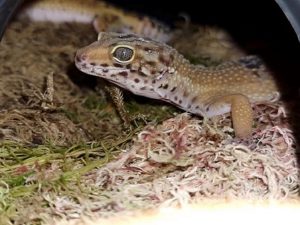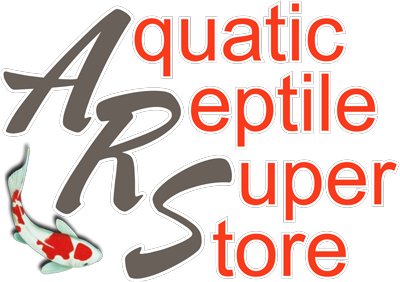Leopard Gecko
Eublepharis macularius

Leopard Geckos come from a wide range in the wild. From India and Pakistan, across the Middle East to Iran. They make fantastic first-time reptile pets as they are docile, fun to watch, and adapt well to handling.
They require a few specifics in their temperature and humidity, but aside from that they are easy to care for and are not particularly fussy when it comes to food.
In the wild they are found in colonies of one Male to several Females, and although they can be kept in such groups in captivity, it is recommended to keep them on their own to avoid fighting and other problems,
Latin Name: Eublepharis macularius
Difficulty Level: Beginner
Temperament: Docile
Life Span: 15 – 20 Years
Size: 7″ – 11″ / 70g – 100g (Males) ¦ 6.5″ – 8″ / 40g – 90g (Females)
Habitat: South Asia and the Middle East – Desert and Forest Edges.
Diet: Mealworms, Locusts, Crickets, Dubia Cockroaches – Dust each insect with Calcium Powder and Vitamin D3 once per week.
Feed adults every 3 days. 1 insect per inch of the Gecko’s body length.
Feed baby Geckos daily.
Avoid feeding them Fruit & Veg, or Meat that isn’t an insect.
Supplements: Calcium, Vitamin D3.
Hours of Activity: Nocturnal – Leopard Geckos are most active at night time.
Handling: Leopard Geckos are easy to handle, and learn to enjoy spending time with their owners. They can drop their tails when spooked, so avoid touching their tails.
Temperature:
24°C – 26°C Ambient day time temperature.
28°C – 30°C Basking temperature.
21°C Minimum ambient night time temperature.
Humidity: 30% – 40%
Vivarium Size: 36″ x 18″ x 18″ (Minimum).
Substrate Type: Sand / Soil Mix, Specialised Leopard Gecko Substrate.
Equipment Necessary: Vivarium, UV Lighting, Heat Lamp, Thermometer, Thermostat.
Cleaning Instructions: Spot clean any waste and uneaten food daily. Replace substrate entirely once per month.
Healthy Behaviour: Fluid movement, solid waste, eating well, active at night and for a short time during the day.
Sick Behaviour: Hissing, detaching of tail, refusing to eat, slow and rigid movement, runny waste, thinning of tail.
Like a lot of Lizards, Leopard Geckos can drop their tail when frightened or as a defence mechanism against predators. The tail will eventually grow back but it will never be the same. It will differ in thickness, length and even colour.
Make sure there are plenty of branches and plants (or plastic plants) for them to climb on, with plenty of hiding spots.
Common Problems:
Endoparasites – If the Leopard Gecko has blood in its feces, it is an indication of internal parasites. Seek veterinary advice.
Dehydration – Always keep the humidity levels between 30% – 40%, or the Leopard Gecko will dehydrate and can die. Correct humidity levels are usually achieved by providing a “Humid Hide” filled with Sphagnum Moss.
Respiratory Infections – If the humidity level is constantly too high, their respiratory systems can get infected. Seek veterinary advice.
Loss of Metabolism and Bodily Functions – This can occur if the temperature is too low. Make sure there is always adequate heating.
